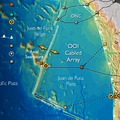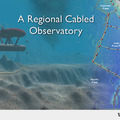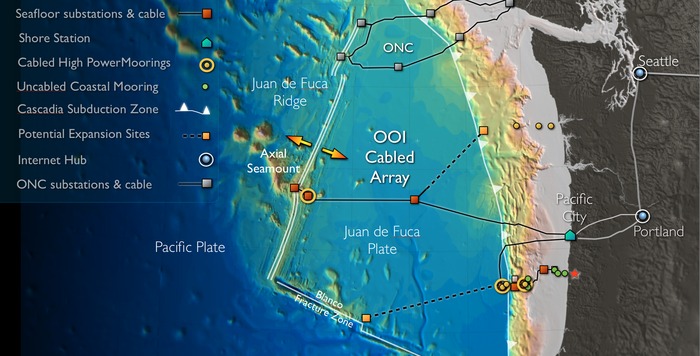The Regional Cabled Array is transforming the way we study and interact with the global ocean.
In 2015, the National Science Foundations' Regional Cabled Array submarine fiber-optic cabled observatory became operational, streaming real-time data to shore from a diverse array of >140 instruments. The network spans the Juan de Fuca tectonic plate, with two cables extending from a Shore Station in Pacific City, Oregon. One branch extends ~480 km due west to Axial Seamount, the largest volcano on the Juan de Fuca Ridge. The voclano is the most active off our coast, erupting in 1998, 2011, and 2015. The second branch extends 208 km southward along the base of the Cascadia Subduction Zone (2900 m) and then turns east extending 147 km to 80 m water depth offshore Newport, Oregon. The system was designed and is now operated and maintained by the University of Washington, Applied Physics Laboratory and School of Oceanography.
The Regional Cabled Array includes six state-of-the-art instrumented, full water column moorings (up to 2900 m water depth) hosting instrumented wire crawlers, winched science pods, and platforms to study linkages among physical, biological and chemical processes spanning blue water to coastal systems along the Cascadia Margin. The coastal array is located at highly productive coastal sites strongly impacted by the California Current, upwelling, ocean acidification, and hypoxia events. The network also includes cutting edge seafloor sensors focused on understanding active volcanism, life in extreme environments, seismicity, and biogeochemical processes and fluxes in actively forming gas hydrate systems. Two-way 24/7/365 communication with direct connection to the Internet, with expansion up to 240 Gb/s and high power (8 kW), allow highly interactive, rapid responses with adaptive sampling to events such as formation of thin layers, large storms, internal waves, volcanic eruptions, and earthquakes.
With an operational life of at least 25 years, the Regional Cabled Array will provide decades of sustained, high quality coregistered, multidisciplinary data at rates up to 250 kilisamples/second and at spatial resolutions of centimeters to kilometers. The high bandwidth and power provides significant expansion capabilities for innovative sensing systems that include advancement of autonomous vehicles with companion docking stations that can change missions in response to changing conditions without human intervention, 3D imagers, and in situ DNA samplers. International installation of progressively advanced submarine cabled observatories will provide unprecedented monitoring of the oceans, and the entrainment of a global community of users – researchers, educators, policy makers and the public.




